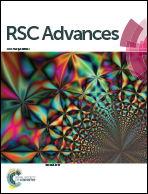Modified photoanodes by amino-containing phosphonate self-assembled monolayers to improve the efficiency of dye-sensitized solar cells
Abstract
Surface modification of TiO2 electrodes by selected molecules could lower the energy barrier of electron transfer and improve DSSC performance. The category of the terminal group and molecular length of a self-assembled monolayer influence the surface and interfacial properties of a TiO2 electrode, and the photovoltaic parameters of a DSSC could thereby be adjusted. By electrochemical approaches, it was discovered that the redox current and photocurrent increased when a lower work function and thus a reduced impedance at the TiO2/dye/electrolyte interface were achieved by using an amino-containing phosphonic acid. However, a smaller photocurrent would be caused when the path for electron transport and charge recombination probability were increased by employing a longer molecule. Both the photocurrent and dark current of a DSSC were suppressed when a larger impedance restrained electron transport through the interface. The TiO2 electrode modified by 2-aminoethylphosphonic acid showed the largest redox current. The corresponding DSSC exhibited the smallest impedance, largest photocurrent and highest efficiency of 6.67%. This study has demonstrated that a monolayer formed on the TiO2 surface by an amino-containing phosphonic acid enhanced DSSC performance efficiently.


 Please wait while we load your content...
Please wait while we load your content...